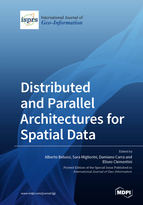Distributed and Parallel Architectures for Spatial Data
A special issue of ISPRS International Journal of Geo-Information (ISSN 2220-9964).
Deadline for manuscript submissions: closed (30 June 2019) | Viewed by 34044
Special Issue Editors
Interests: spatial big data systems; spatio-temporal data analysis; spatial query processing; conceptual design of spatial databases; spatial constraints; spatial data validation
Special Issues, Collections and Topics in MDPI journals
Interests: data management; spatiotemporal information systems; big data and analytics; collaborative and distributed architectures; blockchain technology
Special Issues, Collections and Topics in MDPI journals
Interests: big data systems: design, analysis and evaluation of large scale data processing systems; distributed systems: analysis of the Content Delivery Networks (CDNs), with a focus on cache management policies
Interests: spatial databases; spatial query languages; mathematical modeling of spatial information; computational geometry; spatio-temporal reasoning; wualitative modeling of geographical information; indoor and outdoor navigation; volunteered geographic information
Special Issues, Collections and Topics in MDPI journals
Special Issue Information
Dear Colleagues,
In recent years, an increasing amount of spatial data have been collected by different types of devices, such as mobile phones, sensors, satellites, space telescope, medical tools for analysis, or are generated by social networks, such as geotagged tweets. The processing of this huge amount of information, including spatial properties, which are frequently represented in heterogeneous ways, is a challenging task that has boosted research in the big data area to investigate the case and propose new solutions for dealing with its peculiarities.
Many different proposals and approaches for facing the problem have been proposed in the literature, addressing different goals and different types of users. However, most of them are obtained by customizing existing approaches, which were originally developed for the processing of big data of the alphanumeric type, without any specific support for spatial or spatio-temporal properties. Thus, the proposed solutions can exploit the parallelism provided by these kinds of systems, but without taking into account, in a proficient way, the space and time dimensions that intrinsically characterize the analyzed datasets. As described in the literature, current solutions includes: (i) the on-top approach, where an underlying system for traditional big datasets is used as a black box while spatial processing is added through the definition of user-defined functions that are specified on top of the underlying system; (ii) the from-scratch approach, where a completely new system is implemented for a specific application context; and (iii) the built-in approach, where an existing solution is extended by injecting spatial data functions into its core.
This Special Issue aims at promoting new and innovative studies, proposing new architectures or innovative evolutions of existing ones, or illustrating experiments on current technologies in order to improve the efficiency and effectiveness of distributed and cluster systems when they deal with spatio-temporal data. We invite submissions of either original technical papers or high-quality survey papers that shed new light on a particular perspective on spatial big data systems.
Assoc. Prof. Alberto Belussi
Dr Sara Migliorini
Dr Damiano Carra
Assoc. Prof. Eliseo Clementini
Guest Editors
Manuscript Submission Information
Manuscripts should be submitted online at www.mdpi.com by registering and logging in to this website. Once you are registered, click here to go to the submission form. Manuscripts can be submitted until the deadline. All submissions that pass pre-check are peer-reviewed. Accepted papers will be published continuously in the journal (as soon as accepted) and will be listed together on the special issue website. Research articles, review articles as well as short communications are invited. For planned papers, a title and short abstract (about 100 words) can be sent to the Editorial Office for announcement on this website.
Submitted manuscripts should not have been published previously, nor be under consideration for publication elsewhere (except conference proceedings papers). All manuscripts are thoroughly refereed through a single-blind peer-review process. A guide for authors and other relevant information for submission of manuscripts is available on the Instructions for Authors page. ISPRS International Journal of Geo-Information is an international peer-reviewed open access monthly journal published by MDPI.
Please visit the Instructions for Authors page before submitting a manuscript. The Article Processing Charge (APC) for publication in this open access journal is 1700 CHF (Swiss Francs). Submitted papers should be well formatted and use good English. Authors may use MDPI's English editing service prior to publication or during author revisions.
Keywords
- Big spatial (or spatio-temporal) data processing
- Optimized MapReduce implementation of spatial analysis tools
- Novel indexing methods for massive spatial (or spatio-temporal) data
- Performance studies for spatial (or spatio-temporal) analytics
- Processing of geo-crowdsourced datasets
- Visualization of massive geo-spatial datasets
- Smart City analytics









